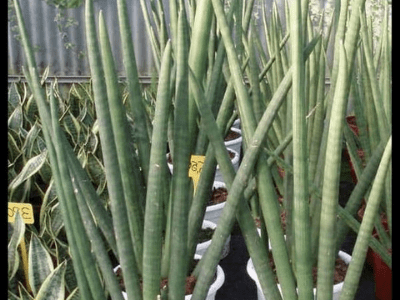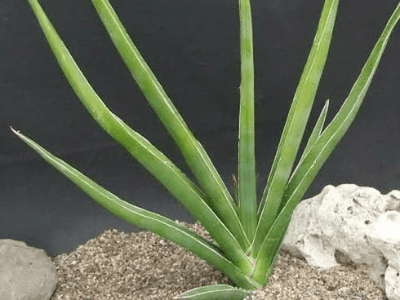
6 Large Snake Plant Varieties
Snake plants (mother in law’s tongue) are a type of succulent with sword-shaped leaves that come in alternate rows.
Although Sansevieria Trifasciata is one of the most commonly known varieties by the name Snake Plant…
it is not the only type. Sansevierias come in a variety of shapes, colors and sizes.
Many very large snake plant, with a height of up to 7 foot, while others are not more than a foot tall.
Miniatures and cultivars like Sansevieria Hahnii Sansevieria Pinguicula and Sansevieria Parva…
…suits the interior better as decorative items, located near windowsills, on tables etc.
In this post we will discuss some with large snake plant leaves that can be grown outdoors…
…as well as indoors in corners of the home and office.
Here we have story from Kean, about his experience having one of large snake plant varieties for the first time.
Let us hear Kean’s story
Snakes are a popular topic for many people. They’re also the inspiration behind my recent interest in snake plants.
I’ve always found snakes fascinating because they are so different from other animals we see on a daily basis…
….and now that I have an understanding of their habits, it’s easier to understand….
…why people have such mixed feelings about them.
I was at work one day when someone mentioned some new types of snake plants that were being sold in stores recently.
Curiosity got the best of me and even though I had never heard anything about this before, I decided to check it out….
online later that evening on Google search results. And what I found is beyond my expectation…
…this plant can grow as large as they want! Man this is so good!
I always love big plant! Finally I bought it online, Sansevieria Trifasciata Prain.

So, for you, plant lovers, we compiled a list of the most popular Sansevieria types with pictures and growing tips, so you can choose the one that suits your style and home best.
Denis Sgarbura, author from youhadmeatgardening.com
Here’s the main things that you should know!
Sansevieria Trifasciata Prain
The Sansevieria Trifasciata Prain is one of the most commonly encountered…
…and most common species of the Sansevieria genus. It is indigenous to tropical west Africa…
…particularly the countries of Nigeria and the Democratic Republic of the Congo.
The plant can be found growing naturally in India, Madagascar, Indonesia and other countries of the tropics.
Other common names for the plant include viper’s bowstring hemp, saint George’s sword, devil’s tongue, etc.
These plants normally grow up to 6 feet tall in bright light conditions.
The leaves are shaped like swords with irregular green stripe pattern.
This plant is a flowering plant and may bloom once a year in the spring.
The plant’s pattern is similar to a snake’s skin, that is why it is called snake plant.

Here’s the thing….
Sansevieria Cylindrica
The snake plant referred to as Sansevieria Cylindrica or Dracaena Angolensis is a popular and attractive plant variety.
The plant is also commonly called an African spear, a Sansevieria spear or a Cylindrical snake plant.
It is endemic to the Angolan rainforest in Southern Africa.
The leaves of African spear plants grow upright, but can also be braided to give them a unique look.
They can grow up to six feet tall and two to three feet wide.
A cylindrical snake plant has cylindrical leaves, referred to as fleshy leaves when in the wild, as they grow.
Upbraided foliage can become fan-shaped as it grows, because it starts bending as a result of its weight.
If you cut them sideways, they have an almost circular cross-section (around one inch diameter).
This plant produces an annual bloom of greenish white flowers on tall flower stalks.
Compared to other types of Sansevieria, this blooms at a much younger age.

Sansevieria Ehrenbergii
The species Dracaena Hanningtonii, often known by it’s common name Sansevieria Ehrenbergii…
has a distinct leaf arrangement. Plants of this species are found mostly in dry areas of eastern Africa…
…and parts of Asia where moist climate doesn’t exist.
The Sansevieria growing in this area is not stemless like most others. It has a short, foot-long stem….
….on which the oval leaves are arranged in two opposite rows.
The foliage forms a highly attractive fan shape that is almost 2 feet wide.
This traditional medicinal plant can be used for a variety of medicinal purposes.
There are many uses for this plant, including treating skin sores and outbreaks, filling in wounds…
and as a natural bandage. Though try to keep pets and children away from the plant…
since it can be mildly poisonous when consumed.
These stunning Sansevieria trifasciata plant has yellow bordered leaves, natural in Africa and Asia.
Sansevieria trifasciatas have an admirable form. Sansevieria Laurentii is known as Variegated Sansevieria…
..Striped snake plant, and Variegated Sansevieria.
There are four species of this species that can grow up to four feet tall and almost a foot wide.
They have succulent leaves with wavy edges and upwards-growing stems.
There is a bright yellow margin surrounding the green leaves that are striped in a manner…
…which is a lot like trifasciata prain.
The hardy snake plant recipient of the Royal Horticultural Society’s Garden Merit award…
…is able to be grown both indoors and outdoors.

Go on…
Sansevieria Stuckyi
It is an evergreen plant that looks like Sansevieria Fischeri. Dracaena Stuckyi…
…is a relatively lesser known species of Sansevieria.
These plants have two kinds of leaves; the juvenile leaves are flat, striped green leaves that grow…
…to form a fountain shape. At the end of the plant’s active phase, the leaves become tough and pointy.
In the picture above, the mature leaves grow upright. It takes 4 to 6 years for the plant to attain the mature stage.
Although the Sansevieria is a perennial, it is not a flowering species. It reaches a maximum height of 6 to 7 feet…
…depending on the growing condition. It has comparatively small flower stalks compared to its height.
Its mature leaves are pale green in color, whereas most snake plants have bright green leaves.
Sansevieria Masoniana
Better known as Whale’s fin, Shark’s fin or Mason’s Congo, Sansevieria Masoniana…
…is a variety of snake plant that has a wide variety of leaves. Plants of this species can be identified by their large..
…fleshy, green colored leaves. It was originally discovered in Congo by Maurice Mason…
…a specimen collector from England. This variety is capable of reaching a height of 6 feet in the appropriate growing conditions.
However, it usually grows to a maximum height of 3 to 4 feet. Leaflets can be up to 7 inches wide in the middle…
..and taper to the edge. The broad, thick leaves are only produced two or three times on a stalk.
In addition, they have pale green smudges on them. The leaves border leaves in a very fine reddish brown line.
Sansevieria Bacularis
An additional stemless plant known as Sansevieria Bacularis looks similar to the cylindrical snake plant…
..Sansevieria Cylindrica. Another Sansevieria variety frequently confused with this one is Sansevieria Fernwood…
…Sansevieria Canaliculata. It is widespread in the Democratic Republic of the Congo.
The name Bacularis is derived from the Latin word baccus meaning a rod or stick.
This plant is tall and slender with slender, stiff cylindrical foliage.
However, the leaves are just half an inch in diameter. Plants will have 1 to 2 leaves growing together on a rough…
…leathery stem, and young leaves (sheaths) are dark purple when young.
It can also make white flowers with purple stripes and grow in thick clusters on a foot-long flower stalk.
Light conditions that are right for the plant can improve its vigor and make it bloom regularly.
How To Care For Sansevieria plants?
Sansevierias are very durable plants that can grow in almost any environment…
..so they’re a great choice for all kinds of gardens.
Watering irregularly and adjusting for heat and low light conditions will eventually cause them to die.
In addition to providing the optimal conditions and proper care, these plants will thrive and become stronger.
Water For Large Snake Plant
A Sansevieria only requires watering once a week. It is drought tolerant and does not need daily watering.
The months of spring and summer are the months when they are growing at a faster rate.
Therefore, you need to feed them and water them more regularly during these months.
In contrast, water less in the winter season, about once a month.
Don’t forget to empty the drainage tray after watering, so the plant does not remain standing in water.
Light and Temperature
In the afternoon, direct sunlight might be too harsh for the plants.
Snake plants grow best in bright and filtered sunlight.
Despite being able to handle full sun, do not suddenly take your plants from a spot with low light to a brightly lit spot.
It’s also best to avoid placing the plants in deeply shadowed corners in the house.
For snake plants, an average room temperature and humidity of 40-50% is ideal.
They do best in temperatures between 50-85°F (10-29°C). Sansevieria plants are tropical species…
…and they are not very hardy in the winter.
When temperatures drop below 45-50°F, they develop scarring and damaging leaves.
When the roots do not keep dry, the roots can even poison the plant.
Soil
It is very significant that snake plant roots don’t remain wet too long in order to prevent root rot.
Soil that is waterlogged can cause death for the plant.
It is recommended that these plants be grown in a soil with a good drainage system.
Best soil ingredients include pumice, perlite, coco coir, gravel, peat, and chicken grit.
Most of these ingredients make the potting mix coarse while retaining enough moisture for the plants.
It is recommended that at least half of the potting mix should include such ingredients.
The remaining part can be regular soil.
Last but not least…
Fertilizer
Don’t fertilize your Sansevieria more than once a month. The best time to fertilize your plant is in spring and summer.
While you may be able to feed your plant all year round if you live in a warmer climate.
Avoid feeding during the winter months as plants do not thrive in colder temperatures.
The diluted form of any general purpose balanced fertilizer works well with snake plants.
You can use liquid fertilizers and slow release granular fertilizers.
Sum Up
See having Snake plant is good choice for you to have! It’s cool, its famous, it’s easy to have and care!
What else do you need? In this pandemic time like this, is a good choice for you to have an new activity…
…and having snake plant is a good choice for you to have!
Conclusion
The following article should help you better understand why repotting is necessary…
…as well as the step-by-step procedure of how to do it. It’s a fun and easy project for your plants.
Last thing for sure. This plant need to be care carefully, remember plant need the “love” too.
Alright that’s all for today! Do you have any questions about all of this?
Or do you want to add some more tips and guide to repot a snake plant?
Let me know your recommendation from the comment below.
There are still many recent and interesting articles about Snake Plants as well as other unique information…
…from All Things Gardener. For further information and other inquiries you can contact us here
I hope you can now take care your snake carefully and grow it big!
Thanks for reading this article! Bye!

